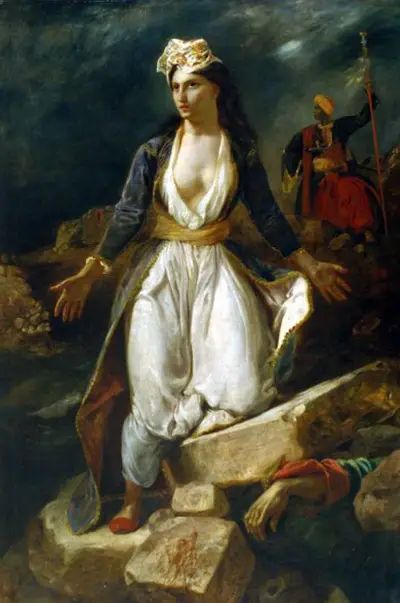Delacroix painted Greece on the Ruins of Missolonghi in 1826, in two months of hard and unrelenting work.
The date is important, for this is not a history painting so much as a 'news' painting; the siege of Missolonghi, which the painting commemorates, happened earlier that year.
In this painting Delacroix clearly shows that like English poet Lord Byron, his sympathies were on the side of the Greek people, attempting to claim their liberty from their Turkish overlords.
As the besieged Greeks of Missolonghi began to suffer from famine and epidemics broke out, they planned an escape; but they were betrayed, and the Turks massacred many, enslaved others, and took the city.
Delacroix shows only the aftermath, and creates a powerful mythic figure to focus the painting.
Greece is shown as a woman in traditional Greek costume, but her bared breast reflects the French Republican figure of Marianne, the symbol of liberty.
Delacroix has also borrowed from images of the Virgin Mary - the out-thrown arms and open palms copy figures of the Madonna of Mercy or perhaps the Pieta, while blue and white draperies recall the Madonna of the Immaculate Conception.
The scene is given emotional intensity by the menacing night sky in the background, and the ruins that threaten to tumble out of the picture frame.
Right at the back of the picture, a turbaned figure plants a flag above the ruins; he is active, proud, and victorious, while Greece is shown as a passive victim.
His red clothing marks a point of contrasting colour in the painting, and might almost be a patch of blood, like the dimly seen streaks of blood on the masonry below.
What Delacroix has done in this painting is to appropriate images from historical art works and put them to work in propaganda; it's a remix or mashup of art history. The intense emotion of the painting, though, makes an impact whether or not the viewer recognises all the references to earlier art.




